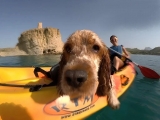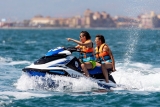A Paradise of Sensations
When planning a diving trip, the key is to choose a destination that captivates us both on land and underwater. This way, we ensure we make the most of our time.
What can be said about the Seychelles Islands? The first impact comes when stepping off the plane and feeling the climate of these latitudes—a warm, humid atmosphere laden with the intoxicating scent of flowers, which may initially feel overwhelming but soon becomes part of the journey’s allure. At night, as the land, weary from the day’s scorching heat, releases a gentle breeze toward the sea, the air brims with the fragrances of its lush vegetation.

Distances on Mahé, the archipelago’s main island, are short, allowing us to explore its most stunning and intriguing spots in a single day. Beyond visiting its capital, Victoria, we can swim at any of the countless beaches dotting its coastline.
Whichever we choose will be spectacular—from Tamanaka in the south to Beau Vallon in the north, including the wild beauty of Grand Anse to the west. Endless sandy stretches and dramatic granite formations line the shore, framed by the ever-present vegetation that often spills into the water.
The sea lapping these idyllic beaches is warm, crystal-clear, and usually calm, though strong tides and currents create powerful surf at certain times of the year.
The True Star: The Sea
Yet, despite the terrestrial beauty, the sea is the undisputed protagonist of the adventure here. The waters surrounding the Seychelles rank among the planet’s most beautiful. At Mahé’s harbour, you’ll find vessels of all kinds—your choice depends on your destination and budget. The most economical way to island-hop is via the small inter-island ferries that daily connect the capital to the archipelago.
The seabed around Mahé isn’t exceptional—it’s mostly rocky terrain lacking the vibrant beauty of coral reefs. Think of it as an extension of the island: vast granite blocks, bare of vegetation, sporadically dotted with sparse coral formations.

But to compensate, the marine life is incredibly rich and diverse. Fish gather in their thousands, whether in dense schools or small groups, displaying remarkable calm around divers—a testament to the strict ban on spearfishing.
Water clarity, vital for diving, varies seasonally. It’s poorest from late December to February and late June to mid-August. However, the farther from shore you go, the better the diving conditions.
Top Dive Sites by Island
Mahé
North Point, where the wreck of a large tanker shelters a kaleidoscopic array of fish. The islets of Ste Anne, Cerf, and Longue—part of Ste. Anne Marine National Park—are a must-visit before tackling more challenging dives.Praslin
A 15-minute flight (with jaw-dropping aerial views) or a leisurely two-hour boat ride brings you to Praslin, the archipelago’s second-largest island. Its vibe is gentler than Mahé’s—less rugged, more serene, yet profoundly beautiful.

Explore at a relaxed pace, starting with the UNESCO-listed Vallée de Mai, home to the rare coco de mer and endangered flora and fauna. This mystical valley of waterfalls and streams deserves far more than the two hours most tours allot.
West of Praslin lie the twin islets Cousin and Cousine, nature sanctuaries teeming with protected seabirds. Despite access restrictions, they’re worth the effort.
Praslin’s waters offer world-class dives: Roche Canal near La Digue, Shark Rock, Alligator Rock en route to Mahé, or Roche Ave Marie toward Aride Island.
These offshore sites have fierce tidal currents (up to 5 knots), demanding meticulous planning. The reward? Breathtaking seascapes and mind-boggling biodiversity. Expect swirling clouds of fish—massive schools of jacks and tuna, plus turtles, rays, and even sharks.

La Digue
Just 1.5 hours southeast of Praslin, this island gem boasts untamed beaches like Grand Anse, Petite Anse, and Anse Cocos—where nature reigns untouched.
Bird Island
If visiting between June and August, don’t miss Bird Island. Perched at the archipelago’s edge, its seabed plummets to 3,000m.
Unlike its granite sisters, Bird is flat, coral-formed, and sparsely vegetated. Why go? Two compelling reasons:

a) For divers, it’s peerless. The surrounding Indo-Pacific marine life thrives in pristine waters, unpolluted and crystal-clear. Pelagic giants—hammerheads, tiger sharks, makos—patrol the drop-offs.
b) For birdwatchers, summer brings a cacophonous spectacle: two million seabirds nesting. The skies blacken at dusk as they return from open-ocean fishing—a deafening, unforgettable sight.

As sunset paints the horizon, we reluctantly weigh anchor, bidding farewell to this true paradise.











